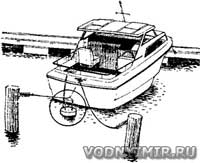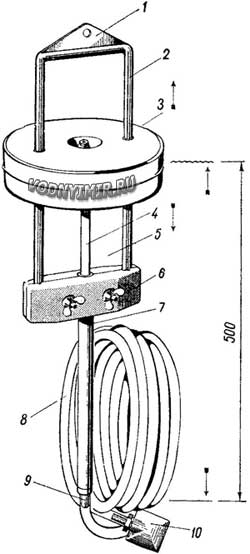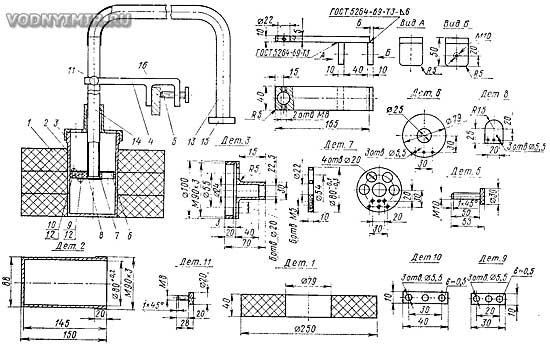«Tumbalense» — automatic pump for pumping water out of the boat
 At many boat and boat stops on the west coast of Norway, bright floats swaying at the sides of ships attract attention. These are «Tumbalens» — automatic drainage pumps, working due to barely noticeable fluctuations of the water surface in the harbor or the rocking of the ship. The name of the device is given by the name of its inventor Sven Tumba.
At many boat and boat stops on the west coast of Norway, bright floats swaying at the sides of ships attract attention. These are «Tumbalens» — automatic drainage pumps, working due to barely noticeable fluctuations of the water surface in the harbor or the rocking of the ship. The name of the device is given by the name of its inventor Sven Tumba.
 «Tumbalens» it is suspended from the ship's side or mooring by a rocker arm 1, equipped with guides 2, so that the round float 3 floated freely on the surface of the water. The float is connected to the rod 4, at the other end of which the pump piston is fixed. The cylinder 7 is clamped in lead castings 6, which hold the device in an upright position. A flexible hose 8 made of plastic with a receiver 10 is connected to the fitting 9, in which the ball valve is mounted> at the end. The length of the hose is 4.5 m, it is thrown through the gunwale inside boats and the receiver is placed in the hold.
«Tumbalens» it is suspended from the ship's side or mooring by a rocker arm 1, equipped with guides 2, so that the round float 3 floated freely on the surface of the water. The float is connected to the rod 4, at the other end of which the pump piston is fixed. The cylinder 7 is clamped in lead castings 6, which hold the device in an upright position. A flexible hose 8 made of plastic with a receiver 10 is connected to the fitting 9, in which the ball valve is mounted> at the end. The length of the hose is 4.5 m, it is thrown through the gunwale inside boats and the receiver is placed in the hold.
When the water level fluctuates or the vessel is pitching, the pump begins to pump water out of the hold, and under favorable conditions, the capacity reaches 20-30 l/h. More is not required — after all, the pump works continuously day and night, removing rainwater from the boat and what can accumulate in the hold from condensation or filtration through the skin. Having put the tumbalens, the owner of the boat will always find it dry, no matter what rains have been pouring all week.
Bilge water comes out of the upper hole 5 of the cylinder, and in order to prevent a possible siphon effect when water can go in the opposite direction from overboard into the boat, there is a non-return valve with a spring-loaded ball in the receiver 10. The third ball valve is available, as on any suction pump, on the piston.
As we were informed by Gunnar Klingenberg from Oslo, who is engaged in the sale of tumbalances, over 10 thousand automatic pumps have been sold in Norway in recent years. They have gained particular popularity among fishermen in Northern Norway using open deckless boats.
And now about the independent manufacture of the automatic pump «Tumbalens».
The pump is simple in design and is available for every amateur to manufacture.
The pump consists of a cylinder in which a piston moves on a hollow rod. The intake and exhaust valves made of oil- and gas-resistant rubber are attached to this piston with screws; brass straps are installed under the screw heads for reliable fastening. The cylinder is closed with a lid, installed on the M90x3 thread. To give stability to the cylinder and prevent misalignment, the lid has a guide Ø22.5 mm in the upper part.
Device and parts of an automatic pump

zoom in, 1000x629, 92.5 KB
1 — float, 3 pcs.; PVC foam; 2 — cylinder, 1 pc.; cast iron; 3 — lid, 1 pc.; 4 — bracket, 1 pc.; St. 3; 5 — screw, 1 pc.; St. 45; 6, 8 — valves, 1 pc.; rubber MB δ=3; 7 — piston, 1 pc.; textolite PT; 9, 10 — slats, 1 pc.; brass L63; 11 — screw, 2 pcs.; St. 45; 12 — screw M5x10; 13 — hose; 14 — stem, pipe 22x1.5; 15 — water intake; 16 — bulwark.
A float is glued on the outside with epoxy glue. A hose is put on the pump stem. To prevent debris from entering the pump cylinder, a water intake with a mesh of any design must be installed at the second end of the hose.
The pump is attached to the hull of the vessel by a steel bracket using a screw. When installed on a wooden case, you can use a screw with a prop. Depending on the height of the boat's side, the rod in the bracket can be moved up or down by fixing it with screws.
When making the pump, the length of the rod and hose is selected depending on the height of the side and the distance between the pump and the water intake. The textolite piston and the stem are connected on an epoxy adhesive. In the manufacture of sharp edges of parts 2, 3, 4 are blunted by a chamfer of 1x45°. The roughness of the treated surfaces not indicated in the drawings is Rz=40. To improve the pump operation and prevent corrosion, the inner surface of the cast-iron cylinder must be lubricated with grease (solidol, constalin, etc.). Outside, all parts are covered with primer and paint.
The pump is installed in such a way that the float lies on the water; inside the boat there is only a hose with a water intake. The pump works as follows. Under the influence of weight, the pump body descends, a vacuum is created in the subshell cavity, the inlet valve opens and water from the vessel's hull through the hose and the rod enters the subshell cavity; when a wave hits due to the buoyancy of the float, the pump body rises, the pressure rises in the subshell cavity, the inlet valve closes and the outlet opens — water is pushed into the the supraporeal cavity. The next time the cylinder is lowered, water flows out of the piston cavity through the holes in the lid, and the next portion of water is sucked into the piston cavity of the pump from the hull of the vessel. To ensure an easy stroke of the cylinder on the piston and sufficient pressure, the cylinder must be made heavy. If it is necessary to obtain a higher level of water lifting, the weight of the movable part (cylinder, lid, float) must be increased.
In the section «Motorboats, boats, yachts — miscellaneous, reviews, tips»
Share this page in the social. networks or bookmark:
